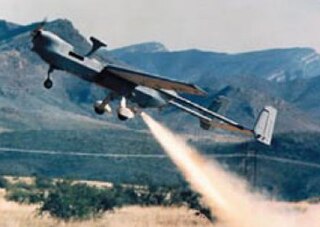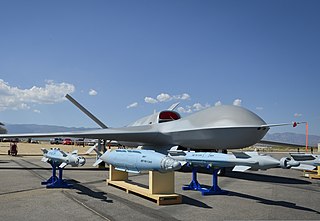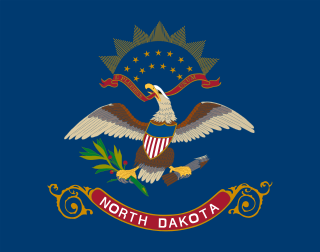Related Research Articles

The RQ-3 DarkStar is an unmanned aerial vehicle (UAV). Its first flight was on March 29, 1996. The Department of Defense terminated DarkStar in January 1999, after determining the UAV was not aerodynamically stable and was not meeting cost and performance objectives.

The Northrop Grumman RQ-4 Global Hawk is a high-altitude, remotely-piloted surveillance aircraft. It was initially designed by Ryan Aeronautical, and known as Tier II+ during development. The RQ-4 provides a broad overview and systematic surveillance using high-resolution synthetic aperture radar (SAR) and electro-optical/infrared (EO/IR) sensors with long loiter times over target areas. It can survey as much as 40,000 square miles (100,000 km2) of terrain per day, an area the size of South Korea or Iceland.

The IAI RQ-5 Hunter unmanned aerial vehicle (UAV) was originally intended to serve as the United States Army's Short Range UAV system for division and corps commanders. It took off and landed on runways. It used a gimbaled EO/IR sensor to relay its video in real time via a second airborne Hunter over a C-band line-of-sight data link. The RQ-5 is based on the Hunter UAV that was developed by Israel Aerospace Industries.

An unmanned or uncrewed aerial vehicle (UAV), commonly known as a drone, is an aircraft without any human pilot, crew, or passengers on board. UAVs are a component of an unmanned aircraft system (UAS), which includes adding a ground-based controller and a system of communications with the UAV. The flight of UAVs may operate under remote control by a human operator, as remotely-piloted aircraft (RPA), or with various degrees of autonomy, such as autopilot assistance, up to fully autonomous aircraft that have no provision for human intervention.

Northrop Grumman Corporation is an American multinational aerospace and defense technology company. With 90,000 employees and an annual revenue in excess of $30 billion, it is one of the world's largest weapons manufacturers and military technology providers. The firm ranks No. 96 on the 2020 Fortune 500 list of America's largest corporations.

The Northrop Grumman MQ-4C Triton is an American high-altitude long endurance unmanned aerial vehicle (UAV) under development for the United States Navy as a surveillance aircraft. Together with its associated ground control station, it is an unmanned aircraft system (UAS). Developed under the Broad Area Maritime Surveillance (BAMS) program, the system is intended to provide real-time intelligence, surveillance and reconnaissance missions (ISR) over vast ocean and coastal regions, continuous maritime surveillance, conduct search and rescue missions, and to complement the Boeing P-8 Poseidon maritime patrol aircraft.

Swift Engineering Inc. is an American spacecraft engineering firm that builds autonomous systems, helicopters, submarines, spacecraft, ground vehicles, robotics, and composite parts. Swift used to produce racing cars for open-wheel racing series, including Formula Ford, Formula Atlantic, the Champ Car World Series and Formula Nippon, having designed and fabricated over 500 race cars.

The Northrop Grumman X-47B is a demonstration unmanned combat aerial vehicle (UCAV) designed for aircraft carrier-based operations. Developed by the American defense technology company Northrop Grumman, the X-47 project began as part of DARPA's J-UCAS program, and subsequently became part of the United States Navy's Unmanned Combat Air System Demonstration (UCAS-D) program. The X-47B is a tailless jet-powered blended-wing-body aircraft capable of semi-autonomous operation and aerial refueling.
Searchlight Airport is a public use airport owned by the U.S. Bureau of Land Management and located two nautical miles (4 km) south of Searchlight, in Clark County, Nevada, United States. The airport is approximately 70 miles (110 km) south of Las Vegas.

The Northrop Grumman Bat is a medium-altitude unmanned air vehicle originally developed for use by the United States Armed Forces. Designed primarily as an intelligence "ISR" gathering tool, the Bat features 30 lb (14 kg) payload capacity that is unmatched in a 10 ft (3.0 m) wing span.

The General Atomics MQ-1C Gray Eagle is a medium-altitude, long-endurance (MALE) unmanned aircraft system (UAS). It was developed by General Atomics Aeronautical Systems (GA-ASI) for the United States Army as an upgrade of the General Atomics MQ-1 Predator.

The General Atomics MQ-20 Avenger is a developmental unmanned combat air vehicle built by General Atomics Aeronautical Systems for the U.S. military.
The Northrop Grumman AN/ZPY-1 STARLite Small Tactical Radar - Lightweight is a small, lightweight synthetic aperture radar/GMTI radar used in tactical operations. The radar is under contract to the U.S. Army Communications and Electronics Command for its ERMP General Atomics MQ-1C Gray Eagle Unmanned Aerial System and is manufactured by Northrop Grumman. STARLite weighs 65 lb (29 kg)., occupies 1.2 cubic feet (34 L), and requires less than 750W of power. The Army began to take delivery of the system in 2010. Also in 2010 the system was ready for deployment to the battlefield.

The Boeing Phantom Ray is an American demonstration stealth unmanned combat air vehicle (UCAV) developed by Boeing using company funds. The autonomous Phantom Ray is a flying wing around the size of a conventional fighter jet, and first flew in April 2011. It will conduct a program of test flights involving surveillance, ground attack and autonomous aerial refueling missions. The developers say it can carry 4,500 pounds of payload.

The Northrop Grumman Firebird is an intelligence gathering aircraft designed by Northrop Grumman's subsidiary Scaled Composites which can be flown remotely or by a pilot. At Scaled, it is known as the Model 355. It was unveiled on May 9, 2011. It was first flown in February 2010 and is considered to be an optionally piloted vehicle (OPV).

Aviation in North Dakota takes place around the state's 89 public airfields, including 8 commercial airports. Notable North Dakota aviators include Carl Ben Eielson, Bruce Peterson, and James Buchli.
The Northrop Grumman RQ-180 is an American stealth unmanned aerial vehicle (UAV) surveillance aircraft intended for contested airspace. As of 2019, there had been no images or statements released, but growing evidence points to the existence of the RQ-180 and its use in regular front-line service.

The Northrop Grumman MQ-8C Fire Scout is an unmanned helicopter developed by Northrop Grumman for use by the United States Navy. The MQ-8C also has autonomous take-off and landing capability. It is designed to provide reconnaissance, situational awareness, aerial fire support and precision targeting support for ground, air and sea forces. The MQ-8C airframe is based on the Bell 407, while the avionics and other systems are developed from those used on the MQ-8B Fire Scout. It first flew in October 2013 and achieved initial operational capability on 28 June 2019.

The Kratos XQ-58 Valkyrie is an experimental stealthy unmanned combat aerial vehicle (UCAV) designed and built by Kratos Defense & Security Solutions for the United States Air Force Low Cost Attritable Strike Demonstrator (LCASD) program, under the USAF Research Laboratory’s Low Cost Attritable Aircraft Technology (LCAAT) project portfolio. It was initially designated XQ-222. The Valkyrie successfully completed its first flight on 5 March 2019 at Yuma Proving Ground, Arizona.
References
- ↑ "Groundbreaking on Grand Sky project represents years of preparation". 10 September 2015.
- ↑ "Prairie Business".
- ↑ "General Atomics Completes First Flight at Grand Sky".
- ↑ "Archived copy". Archived from the original on 2017-02-14. Retrieved 2017-02-13.
{{cite web}}: CS1 maint: archived copy as title (link) - ↑ "UAS Magazine – the Latest News on Unmanned Aerial Systems - Training academy graduates first General Atomics aircrews".
- ↑ "UAS Magazine – the Latest News on Unmanned Aerial Systems - EdgeData planning world-class data center at Grand Sky".
- ↑ "Archived copy". Archived from the original on 2017-02-05. Retrieved 2017-02-13.
{{cite web}}: CS1 maint: archived copy as title (link)